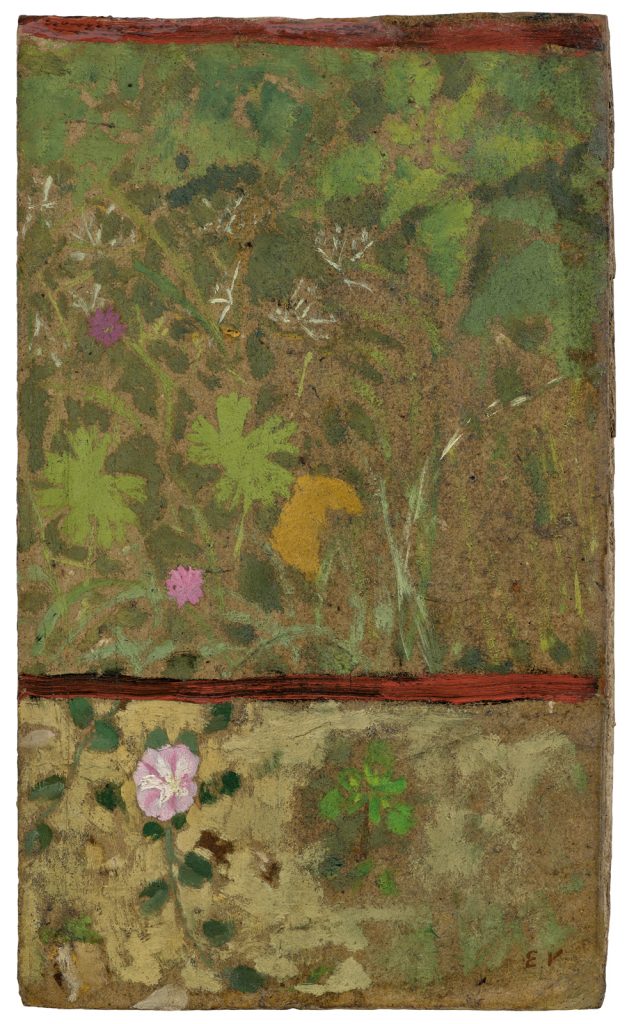Édouard Vuillard
(Cuiseaux 1868 – 1940 La Baule)
Le Pétunia, circa 1889-90
Oil on cardboard, 27.5 x 16.5 cm
Stamped with the initials lower right: EV (Lugt 909a)
Provenance:
The artist’s studio, Paris;
Galerie Bérès, Paris;
François Reichenbach, Paris;
Private collection, USA;
Inna and Boris Salomon, Paris.
Literature:
Antoine Salomon and Guy Cogeval, Vuillard, Le regard innombrable, Catalogue critique des peintures et pastels, Paris 2003, I, p. 97, fig. II-36.
Seen obliquely from above is a colorful patch of flowering plants and greenery in a garden, viewed from a sliding sash window. The bottom rail of the raised lower sash divides the picture plane into two unequal sections – approximately one third lies below it and two thirds above. In the lower section, the viewer looks directly out into the open air but in the upper section, a window pane dulls his view. By choosing a high viewpoint and largely dispensing with classic perspective Vuillard emphasizes the effect of two-dimensionality. He thus offers the viewer two options – the painting can either be read as a representational work or as a non-objective, abstract image. Leaves, stalks, blades of grass and flowers are scattered over the surface, patterning it with detail. The warm earth tones of exposed areas of the support, a sheet of untreated brown cardboard, serve as ground and add a compositional element to this small nature study. Vuillard’s very different use of paint in the lower and upper sections is a particularly attractive feature of the oil. His handling of the directly perceived patch of garden shown in the lower section of the image is in clear contrast to the more muted tones of the view depicted in the upper section, seen through the window pane. Here, paints have a watery quality and the brushstrokes are cursory and imprecise. But in the lower section, touches of robust impasto accentuate contours and heighten coloristic effect. Shimmering accents of white and pink single out the petunia that has given this little picture its title.
Vuillard grew up in modest circumstances. His father died early. Thanks to the latter’s military decoration – he was awarded the Légion d’Honneur – Vuillard was able to study at one of the best schools in Paris, the Lycée Condorcet. His mother came from a family of textile designers. She supported the family running a small dressmaking business. Vuillard lived in her household continuously until her death in 1928. They moved house a number of times and in each of their rented apartments he set up a studio in his bedroom. His pictorial world emerged in the intimacy of this feminine environment of petit-bourgeois industriousness and domesticity – he jokingly called himself an intimiste.
Vuillard trained briefly under Jean-Léon Gérôme in 1888 before continuing his studies in the freer atmosphere of the Académie Julian, like many other groundbreaking artists of his generation. He made his début at the Salon des Indépendants in Paris in 1891. Friendships with his former schoolfellows, the brothers Alexandre and Thadée Natanson, publishers of the influential art journal La Revue Blanche, brought him his first decorative commissions. He was a gifted and prolific printmaker, receiving commissions for lithographs from the Nathansons and from the dealer and publisher Ambroise Vollard.
In 1889, Vuillard’s friend Maurice Denis (1870–1943) introduced him to a self-styled group of fellow Académie Julian students who identified themselves as Les Nabis (from the Hebrew for prophet). Among the better-known members were Félix Vallotton (1865–1925), Paul Sérusier (1864–1927), Pierre Bonnard (1867–1947) and Ker-Xavier Roussel (1867–1944). These young artists were united in their rejection of the illusionistic modelling demanded by academic teaching. However they followed individual paths away from naturalism towards a style of painting that Gauguin dubbed Synthetism. They aimed to rejuvenate painting and experimented with a new conception of pictorial space which dispensed with classic perspective and modelling of light and shade. They used form and color to express individual emotions and sensations, relying on memory and imagination stimulated by, but not directly imitating the observed world. It was a decorative style that employed broad areas of pure, non-naturalistic color to produce large patterns of simple, flat forms and sinuous lines which recall the pictorial language of Japanese woodblock prints.[1] In the 1860s to 1880s, Japanese art and design, in particular the ukiyo-e print, significantly influenced stylistic trends across Europe.[2]
The subjects of most of his works were intimate, private domestic environments and garden views. In the present oil Vuillard handles forms freely and schematically, evading depth and omitting points of spatial reference. The decorative influence of the Nabis and of japonisme is evident. Rejecting illusionistic imitation and affirming the natural two-dimensionality of the support, he develops ingenious harmonies from the interaction of simplified, unmodeled floral motifs. In doing so, he treats all the elements in his painting as equal components of an ornamental whole.
- Francesca Berry, Édouard Vuillard: Nabi and intimist, <https://artuk.org/discover/stories/douard-vuillard-nabi-and-intimist> (accessed May 18, 2022).
- Elise Dubreuil et al. (eds.), Les Nabis et le Décor. Bonnard, Vuillard, Maurice Denis, exhib. cat., Paris 2019.

